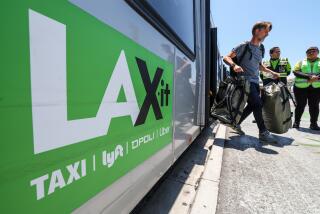High Praise From Disabled for Airport’s New Terminal
- Share via
COSTA MESA — One year ago, a group of local disabled activists conducted a hastily arranged, pre-opening tour of the Thomas F. Riley Terminal at John Wayne Airport and jolted airport officials with their observations.
The activists were impressed with the overall design and accessibility of the new terminal, but several features appeared to violate state building codes, they told the red-faced officials who accompanied them.
Among the apparent violations cited were too few wheelchair ramps at entrances and pathways, and pay phones, drinking fountains, restroom mirrors and towel and soap dispensers that exceeded height limits.
County building inspectors, fearing the ramifications of the $63-million project being out of compliance with state regulations, quickly arranged their own inspection tour.
“The situation was addressed pretty extensively by staff because there was a concern it might be a noncompliance matter” only days before the grand opening, William E. Eckles Jr., manager of the county building inspection branch, said recently.
As the terminal celebrates its first anniversary, some of the concerns that were raised have not been addressed, nor are they likely to be, because of cost considerations, airport officials said.
Still, representatives of disabled groups said that they are generally pleased with the design changes that have been made, and they give the terminal high marks for accessibility.
“We pointed out some (details) that were an inconvenience, but overall I thought and still think it is one of the best facilities in the world,” said travel agent Ken Force, a wheelchair user who was part of the original tour group.
Airport officials had maintained that no state codes were violated but agreed nevertheless to several design modifications. Stalls for the handicapped in restrooms were refitted so that doors swing out instead of in and were equipped with self-closing devices. Spots for the handicapped in parking garages were restriped and modified.
In addition, markers that aid the visually impaired were added to an elevator that whisks visitors to a VIP area.
Other features--such as the pay phones and drinking fountains that are too high for some--were determined to be too minor to warrant the extensive redesign that would have been required, said Ronald D. Mincer, a building code expert and consultant to the state Department of Rehabilitation.
Mincer, a paraplegic who participated in the original tour, has been working with airport officials and county building inspectors to ensure that state guidelines for handicapped access are followed.
He said he is satisfied with the cooperation he has received except on one point--the outside ramps. Airport officials and county building inspectors say the terminal complies with state codes that require curb cuts or ramps at “primary entrances and wherever a pedestrian path crosses a curb.”
At the new terminal, such ramps are located only at the four main entrances. Mincer insists that the guidelines require more ramps but said the issue is not likely to be forced unless someone makes a formal complaint.
“In every building you go into, you can find a few things that are not quite right--it’s the nature of building. But there are no major problems,” Mincer said. “It’s a pleasure to go into compared to the old building.”
Except for a few minor complaints, other handicapped travelers agreed.
Force noted, for example, that in the old terminal, handicapped travelers could park free of charge in marked spots and at meters. In the new terminal, handicapped passengers must pay a parking fee. (But the fee is only half the regular rate, airport operations manager William Pemberton said, to compensate for the fact that shuttle buses serving remote, low-fee lots are not accessible by wheelchairs.)
Force also said some wheelchair users might find airline and car-rental countertops too high to be used comfortably.
Others said areas of the terminal occasionally are closed during off hours, impeding access to some elevators and entrances.
But generally, the new terminal has won rave reviews from disabled travelers.
“The accessibility has increased dramatically from the old terminal,” said Richard Melli, program manager at the Dayle McIntosh Center for the Disabled in Anaheim.
More to Read
Sign up for Essential California
The most important California stories and recommendations in your inbox every morning.
You may occasionally receive promotional content from the Los Angeles Times.











